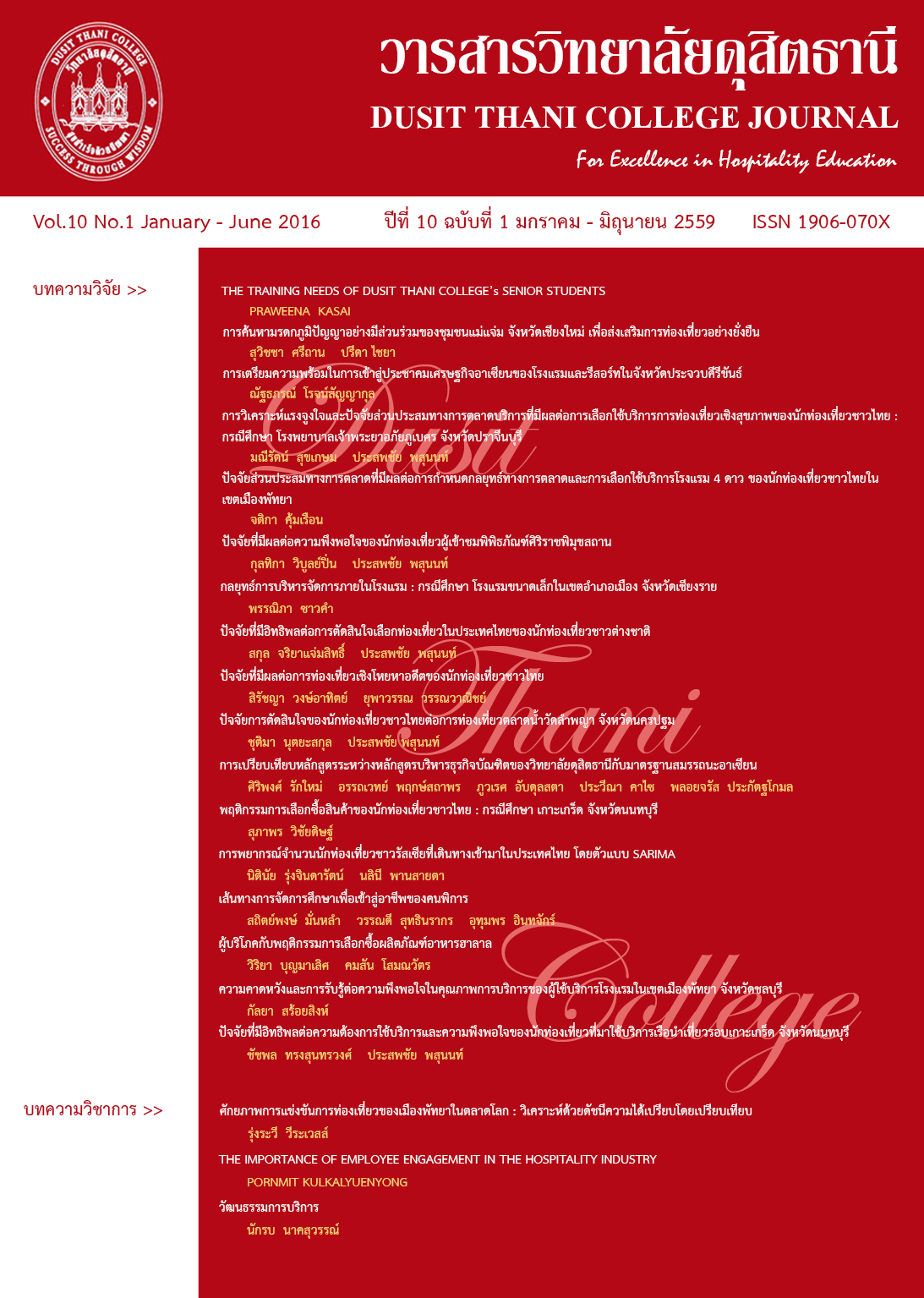ปัจจัยที่ส่งผลต่อการเลือกซื้อผลิตภัณฑ์อาหารฮาลาล
Main Article Content
บทคัดย่อ
การวิจัยครั้งนี้มีวัตถุประสงค์ 1) เพื่อศึกษาความสัมพันธ์ระหว่างปัจจัยเชิงสาเหตุด้านผลิตภัณฑ์กับพฤติกรรมในการเลือกซื้อผลิตภัณฑ์อาหารฮาลาล 2) เพื่อตรวจสอบความสอดคล้องของความสัมพันธ์เชิงสาเหตุของโมเดลที่สร้างขึ้นกับข้อมูลเชิงประจักษ์ 3) เพื่อศึกษาปัจจัยที่มีอิทธิพลทั้งทางตรงและทางอ้อมที่ส่งผลต่อการเลือกซื้อผลิตภัณฑ์อาหารฮาลาลโดยใช้การเลือกตัวอย่าง 3 ขั้นตอนคือการสุ่มตัวอย่างแบบง่าย (Simple Random Sampling) แบบโควต้า (Quota Sampling) และแบบเจาะจง (Purposive Sampling) จำนวน 400 คน สถิติที่ใช้ในการวิเคราะห์ข้อมูลได้แก่ ค่าเฉลี่ย ร้อยละ ความถี่ และค่าเบี่ยงเบนมาตรฐาน
t-test และใช้วิธีการวิเคราะห์ความแปรปรวนทางเดียว (One Way ANOVA) ผลการวิจัยพบว่า
กลุ่มตัวอย่างเป็นเพศชายจำนวน 178 คน คิดเป็นร้อยละ 44.5 และเพศหญิงจำนวน 222 คน คิดเป็น ร้อยละ 55.5 ส่วนใหญ่อยู่ในช่วงอายุตั้งแต่ 41 ปีขึ้นไป จำนวน 102 คน คิดเป็นร้อยละ 25.50 มีการศึกษาระดับปริญญาตรี มีจำนวน 147 คน คิดเป็นร้อยละ 36.75 มีสถานภาพสมรสมากที่สุดมีจำนวน 228 คน คิดเป็นร้อยละ 57.00 สถานภาพโสด มีจำนวน 138 คน คิดเป็นร้อยละ 34.50 ส่วนใหญ่มีรายได้ 10,001 – 15,000 บาท จำนวน 109 คน คิดเป็นร้อยละ 27.25
ด้านพฤติกรรมในการเลือกซื้ออาหารฮาลาล พบว่ากลุ่มตัวอย่างเลือกซื้อผลิตภัณฑ์ที่มีเครื่องหมายฮาลาลมากที่สุดร้อยละ 87.25 รองลงมาให้เกณฑ์เรื่องความถูกต้องตามหลักศาสนาคิดเป็นร้อยละ 82.25 และพบว่า กลุ่มตัวอย่างเลือกซื้อผลิตภัณฑ์ที่เป็นแบรนด์ดังในประเทศไทย หาซื้อได้ทั่วไปร้อยละ 88.75 และเลือกซื้อผลิตภัณฑ์ที่เป็นแบรนด์ที่นำเข้าจากต่างประเทศร้อยละ 11.25 โดยครอบครัวมีอิทธิพลต่อการเลือกซื้อผลิตภัณฑ์มากที่สุดร้อยละ 62.50 รองลงมาได้แก่ การโฆษณาร้อยละ 21.75 ในด้านแหล่งข้อมูลเกี่ยวกับผลิตภัณฑ์อาหารฮาลาล พบว่า ส่วนใหญ่ได้รับข้อมูลจาก ญาติ/เพื่อน มากที่สุดร้อยละ 75.25 โดยซื้อวัตถุดิบประกอบอาหาร เช่น ผัก เนื้อสัตว์มากที่สุดร้อยละ 64.50 ด้านสถานที่ซื้อผลิตภัณฑ์อาหารฮาลาล พบว่า ซื้ออาหารจากตลาดสดมากที่สุดร้อยละ 54.75 ด้านรูปแบบการจัดจำหน่ายผลิตภัณฑ์อาหารฮาลาล พบว่า ส่วนใหญ่ซื้อผลิตภัณฑ์ที่ความสะดวกของสถานที่ซื้อมากที่สุดร้อยละ 71.75 ด้านกิจกรรมส่งเสริมทางด้านการตลาดที่ต้องการให้ผู้ขายผลิตภัณฑ์อาหารฮาลาล พบว่ากลุ่มตัวอย่างต้องการกิจกรรมการส่งเสริมการตลาดที่มีส่วนลดในการซื้อสินค้ามากที่สุดร้อยละ 73.75
ปัจจัยด้านทัศนคติหรือเจตคติ พบว่า กระบวนการผลิตถูกต้องตามหลักศาสนบัญญัติอิสลามให้ความสำคัญมากที่สุด(ค่าเฉลี่ย= 4.64) ปัจจัยด้านผลิตภัณฑ์ พบว่าข้อ มีคุณภาพ สดใหม่ และมีความหลากหลายให้เลือก และมีเครื่องหมายฮาลาล รับรอง มีความสำคัญที่สุดเท่ากัน (ค่าเฉลี่ย = 4.66) ตามลำดับ
Article Details
นโยบายการพิจารณากลั่นกรองบทความ
- บทความวิจัยและบทความวิชาการทุกเรื่องที่จะได้รับการตีพิมพ์ต้องผ่านการพิจารณากลั่นกรองโดยผู้ทรงคุณวุฒิ (Peer Review) ในสาขาที่เกี่ยวข้อง จำนวน 3 ท่าน/บทความ
- บทความ ข้อความ ภาพประกอบและตารางประกอบที่ลงตีพิมพ์ในวารสารเป็นความคิดเห็นส่วนตัวของผู้เขียน กองบรรณาธิการไม่จำเป็นต้องเห็นด้วยเสมอไป และไม่มีส่วนรับผิดชอบใด ๆ ถือเป็นความรับผิดชอบของผู้เขียนแต่เพียงผู้เดียว
- บทความที่จะได้รับการตีพิมพ์จะต้องไม่เคยตีพิมพ์ เผยแพร่ที่ใดมาก่อน และไม่อยู่ระหว่างการพิจารณาของวารสารฉบับอื่น หากตรวจสอบพบว่ามีการตีพิมพ์ซ้ำซ้อน ถือเป็นความรับผิดชอบของผู้เขียนแต่เพียงผู้เดียว
- บทความใดที่ผู้อ่านเห็นว่าได้มีการลอกเลียนหรือแอบอ้างโดยปราศจากการอ้างอิง หรือทำให้เข้าใจผิดว่าเป็นผลงานของผู้เขียน กรุณาแจ้งให้กองบรรณาธิการวารสารทราบจะเป็นพระคุณยิ่ง
เอกสารอ้างอิง
พิทักษ์ ก่อเกียรติพิทักษ์. (2543). “ศักยภาพด้านการผลิตอาหารฮาลาล: ศึกษากรณีจังหวัดปัตตานี” กรุงเทพฯ : ภาคนิพนธ์ปริญญามหาบัณฑิต คณะพัฒนาสังคม สถาบันบันฑิตพัฒนบริหารศาสตร์.
พิบูล ทีปะปาล. (2537). หลักการตลาด. กรุงเทพฯ: อมรการพิมพ์.
สมยศ นาวีการ. (2540). การบริหารและพฤติกรรมองค์กร. กรุงเทพฯ : ผู้จัดการ.
สมบุญ รุจิขจร. (2553). GREEN BRAND EFFECT. BrandAge, 11(2) (กุมภาพันธ์.
เสรี วงษ์มณฑา. (2540). ครบเครื่องเรื่องการสื่อสารการตลาด. กรุงเทพฯ: วิสิทธิ์พัฒนา.
สาลิกา ค้าสุวรรณ. (2554). นโยบายส่งเสริมการส่งออกอาหารฮาลาลไทย และปัจจัยที่ส่งออกต่อภาพลักษณ์
อาหารฮาลาลไทยในกลุ่มผู้บริโภคมุสลิมตะวันออกกลาง. วารสารศรีนครินทรวิโรฒวิจัยและพัฒนา(สาขามนุษยศาสตร์ และสังคมศาสตร์), 3(6): 137-161
ศูนย์วิทยาศาสตร์ฮาลาล. (2554). ฮาลาลสินค้าอีกกลุ่มที่ท้าทายยอดส่งออก. (ออนไลน์). เข้าถึงได้จาก
http://www.halalscience.org/th/main2011/content.php?page=sub&category=73&id=21.
วันที่เข้าถึง:17 มีนาคม 2556.
Ajzen, I., & Fishbein, M. (1980). Understanding attitudes and predicting social behavior. Englewood Cliffs, NJ: Prentice-Hall.
Kotler, P., & Armstrong, G. (1997). Marketing: An introduction. Upper Saddle River,New Jersey: Prentice- Hall.
Riaz, M. N. (1998). “Halal Food - An Insight Into AGrowing Food Industry Segment,” InternationalFood Marketing & Technology, (December).


